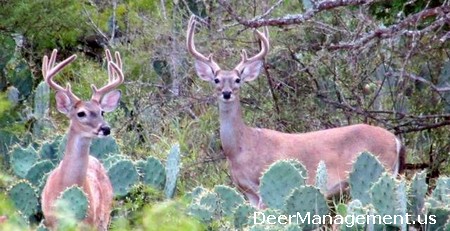Question: I have about 500 acres that I try to manage to for whitetail deer. The property is low fenced on two sides because one of my neighbors put up a high fence. On one side is a very large ranch that does not protein feed, so I draw a lot of deer in with the protein pellets I offer during much of the year. Trying to figure out what is the correct number of deer per acre that I should have, proper carrying capacity?
If I attempt to manage the herd for 1 deer for every 8 acres, then how many acres of that big ranch should I include in my total acreage since they remove very few deer on any given year. I know that I have way too many whitetail on my property and I am trying determine the right number of deer to harvest. Would adding another 150 to 250 acres to account for the larger neighboring property and my 500 acres be reasonable? In other words I would be managing about 650-750 acres, but the harvest would take place on 500 acres.

Response: Determining the right number of deer per acre for any property is important for whitetail deer management. However, there is no good answer to this question without seeing the habitat present on both your and your neighbor’s property. The correct answer depends on your soils and associated plant communities, the habitat management history of the property, rainfall as well as the current management practices.
Some properties can safely operate 1 deer for every 8 acres while others must keep their deer density closer to 1 deer per 15 or 25 acres. This varies across the whitetail deer’s range as well as from property to property. The number of deer you should have on a given property is a moving target and must be evaluated on a case by case basis.
The larger ranch next to your property is an issue that you can not address directly, but you can at least impact some of the deer numbers in the area through increased harvest. The removal of deer will in effect contribute to habitat improvement on both places because of a decrease in the number of browsing animals.
My recommendation would be to stick to managing the animals on your 500 acres and ignore the neighboring property. It does not technically matter if you include some of their acreage and some of the deer found on their property in your management plan because it will not impact the deer density found on your property.
The deer density across the fence is the same as that of your property. In short, there could be 1 deer for every 5 acres for 10 square miles. So what? You can only impact your property, though the number of deer you choose to harvest will impact the neighbors to some degree. There really is not good answer to this broad question without knowing more about your land and the whitetail deer found there.
In order to manage the deer found on your place you first need to start with estimating the number of whitetail found on your property, so surveys for deer are a must. This is critical since without a good estimate you will be shooting in the dark. This number may be as important as anything since it will give you a baseline for your management program. Then, your objectives may include decreasing the population by 20 percent or changing the buck to doe ratio.
Once you reach these objectives, examine the status of the habitat found on your property as well as the deer herd and see if it meets the goals you set out to accomplish. If so, then manage the deer herd to maintain what you have. If not, change the target population number and keep going. This management strategy may get you to where you want to be without initially setting a hard number of deer per acre/deer density goal.















































